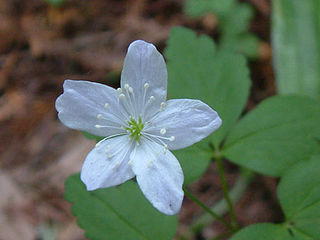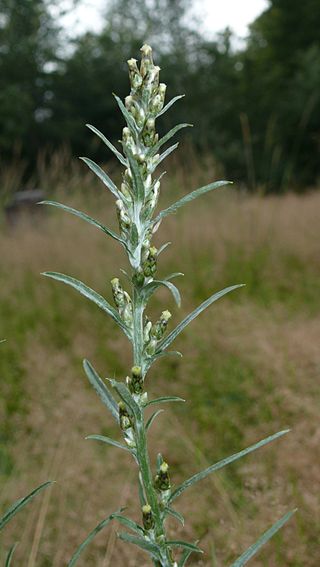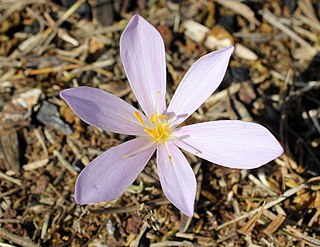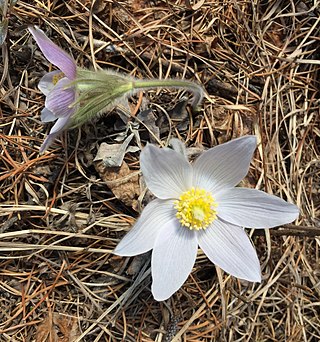
Symphyotrichum novae-angliae is a species of flowering plant in the aster family (Asteraceae) native to central and eastern North America. Commonly known as New England aster, hairy Michaelmas-daisy, or Michaelmas daisy, it is a perennial, herbaceous plant usually between 30 and 120 centimeters tall and 60 to 90 cm wide.

Lysimachia europaea is a flowering plant in the primrose family Primulaceae, called by the common name chickweed-wintergreen or arctic starflower. It is a small herbaceous perennial plant with one or more whorls of leaves on a single slender erect stem. It is about one third of a foot high (10 cm). The broad lanceolate leaves are pale green but take on a copper hue in late summer. The solitary white flowers are reminiscent of small wood anemones and appear in midsummer. The fruits are globular dry capsules but are seldom produced.

Centipeda cunninghamii is a species of flowering plant in the Asteraceae family. It is referred to by the common names old man weed, being the literal translation of its Koori name gukwonderuk, common sneezeweed and scent weed which were given by European settlers but are increasingly falling out of use. The plant was used by indigenous Australians for its purported medicinal properties. It grows along the Murray River, or generally anywhere there is water, especially low lying or swampy areas. It can be identified by its unique shaped leaf and its pungent scent which is pine-like and minty.

Anemonoides quinquefolia, a flowering plant in the buttercup family Ranunculaceae, is native to North America. It is commonly called wood anemone or windflower, not to be confused with Anemonoides nemorosa, a closely related European species also known by these common names. The specific epithet quinquefolia means "five-leaved", which is a misnomer since each leaf has just three leaflets. A plant typically has a single, small white flower with 5 sepals.

Clerodendrum thomsoniae is a species of flowering plant in the genus Clerodendrum of the family Lamiaceae, native to tropical west Africa from Cameroon west to Senegal. It is an evergreen liana growing to 4 m (13 ft) tall, with ovate to oblong leaves 8–17 cm (3–7 in) cm long. The flowers are produced in cymes of 8–20 together, each flower with a pure white to pale purple five-lobed calyx 2.5 cm in diameter, and a red five-lobed corolla 2 cm long and in diameter. The flowers are born in cymose inflorescences arising from the axils of the leaves. The leaves, in turn, are arranged opposite to each other and at right angles to the pairs above and below.

Helleborus cyclophyllus is a flowering perennial plant in the family Ranunculaceae. It is native to Albania, Bulgaria, Greece, and Yugoslavia. It is similar in appearance to other hellebores found in the Balkan region. It is acaulescent, meaning it lacks a stem with leaves, instead sending up a leafless flower stalk. The green leaves are palmate and basal, spreading at the ground. The flowers are green to yellow-green and 2 to 3 inches in diameter.

Symphyotrichum lateriflorum is a species of flowering plant in the aster family (Asteraceae). Commonly known as calico aster, starved aster, and white woodland aster, it is native to eastern and central North America. It is a perennial and herbaceous plant that may reach heights up to 120 centimeters and widths up to 30 centimeters.

Salvia taraxacifolia is a species of flowering plant in the Lamiaceae family. It is referred to by the common name Dandelion leaved sage and is a herbaceous perennial shrub that is endemic to southwest Morocco, growing in the Atlas Mountains at elevations ranging from 2,000 feet (610 m) to 8,000 feet (2,400 m). Very adaptable, it grows on limestone slopes, forest clearings, and rocky riversides. It has no close allies in the genus Salvia. The specific epithet, taraxacifolia, is likely Persian in origin and means 'leaves shaped like a dandelion'.

Omalotheca sylvatica, synonyms including Gnaphalium sylvaticum, is a species of plant in the family Asteraceae. It is commonly known as heath cudweed, wood cudweed, golden motherwort, chafeweed, owl's crown, and woodland arctic cudweed. It is widespread across the temperate Northern Hemisphere, throughout North America and Eurasia. The species was first formally described by Carl Linnaeus in 1753 as Gnaphalium sylvaticum.

Aframomum corrorima is a species of flowering plant in the ginger family, Zingiberaceae. It's a herbaceous perennial that produces leafy stems 1–2 meters tall from rhizomatous roots. The alternately-arranged leaves are dark green, 10–30 cm long and 2.5–6 cm across, elliptical to oblong in shape. Pink flowers are borne near the ground and give way to red, fleshy fruits containing shiny brown seeds, which are typically 3–5 mm in diameter.

Sedum spathulifolium is a species of flowering plant in the family Crassulaceae known by the common names broadleaf stonecrop, yellow stonecrop, and spoon-leaved stonecrop. An evergreen perennial, it is native to western North America from British Columbia to southern California, where it can be found often in shade in many types of rocky habitat in coastal and inland hills and mountains.

Colchicum micranthum is a species of flowering plant in the family Colchicaceae. It is native to Turkey with nearly white flowers barely 2 cm (.75") tall. It produces a series of blooms throughout the fall. The leaves follow the flowers, and are usually 3–5 in number.
Eucrosia mirabilis is a species of plant from Ecuador. In the original scientific description in 1869, it was believed to be from Peru, but there is little evidence it ever grew there. The plant disappeared from cultivation until it was found in Ecuador in 1997. Its natural habitats are seasonally dry lowland areas to elevations of 1500 m.

Pulsatilla nuttalliana, known as American pasqueflower, prairie pasqueflower, prairie crocus, or simply pasqueflower, is a flowering plant native to much of North America, from the western side of Lake Michigan, to northern Canada in the Northwest Territories, south to New Mexico in the southwestern United States. Pasqueflower is the provincial flower of Manitoba and the state flower of South Dakota.

Solanum opacum is a species of flowering plant in the family Solanaceae. It is referred to by the common names green berry nightshade, or morelle verte and is a sprawling annual native to eastern Australia. It is part of the black nightshade group of Solanum species.

Tulipa armena is a species of flowering plant in the Liliaceae family. It is referred to by the common name Armenian tulip, and is native to the historical Armenian Highlands as the name implies; current regions of Armenia, modern day Turkey, Iran, South Caucasus, and Azerbaijan.

Linnaea floribunda, also known as Mexican abelia, is a species of flowering plant in the honeysuckle family, Caprifoliaceae, native to Mexico.
Garcinia binucao is a species of flowering plant in the Clusiaceae family. It is commonly known as binukaw or batuan, is a species of Garcinia endemic to the Philippines. It is not cultivated, though its edible fruits are harvested from the wild for use as a souring agent in some Filipino dishes.

Symphyotrichum racemosum is a species of flowering plant native to parts of the United States and introduced in Canada. It is known as smooth white oldfield aster and small white aster. It is a perennial, herbaceous plant in the family Asteraceae. It is a late-summer and fall blooming flower.

Symphyotrichum molle is a species of flowering plant in the aster family (Asteraceae) endemic to the Bighorn Mountains of Montana and Wyoming in the United States. Commonly known as soft aster, it is a perennial, herbaceous plant that ranges from 30 to 60 centimeters in height.


















